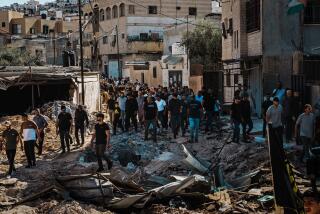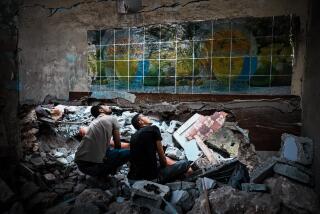Once Again, Basra Becomes Target as War Returns to the Strategic City : Iraq: The military and transportation hub was a vital site in the war with Iran. Now U.S. and allies are bombing it.
MANAMA, Bahrain — Along the waterfront in Basra, Iraq’s second-largest city, is a surreal vision: life-sized statues of Iraqi soldiers pointing into the distance toward the place they died during the Iran-Iraq War.
Once again, Basra has become a killing ground, this time from allied air forces that have been pounding installations in the city virtually since the outbreak of war.
Basra’s strategic location just 40 miles north of the Kuwait border has placed the city and its 1.5 million inhabitants in the front lines of the conflict with the U.S.-led military alliance.
Air strikes on the city have been so intense that Iran’s official news agency reported on Saturday that residents of the Iranian city of Khorramshahr, 20 miles to the east, could see and feel the bomb blasts.
“The sky of Basra and the vicinity was lit with each explosion,” the Iranian press agency said.
The key to Basra’s strategic significance lies in a remark made by Gen. Colin L. Powell, chairman of the U.S. Joint Chiefs of Staff, who said of Iraq’s tough Republican Guard in Kuwait: “First we are going to cut it off, and then we are going to kill it.”
Basra lies on the Shatt al Arab, a waterway formed from the confluence of the Tigris and Euphrates rivers leading into the northern Persian Gulf. The home of Sinbad the Sailor of folklore, Basra was until the outbreak of the Iraq-Iran War Iraq’s only deep-water port.
Even though the river was closed during the eight-year conflict, Basra took on a military significance that endures. It became army corps headquarters for Iraq’s armies in the southern war theater and is now believed to be the headquarters for all of Saddam Hussein’s troops stationed in Kuwait.
It was at Basra, against Iran, that the Iraqi army perfected the multilayer defense--composed of concentric rings of barbed wire, tank traps and even irrigation canals--that they have deployed against allied forces in southern Kuwait. Iran’s failure to break through the siege lines in 1987 marked a crucial point in the war, which eventually ended in stalemate.
“Basra is a significant target with much of Iraq’s command and communications structure there,” said Philip Mitchell, a defense analyst at London’s International Institute for Strategic Studies. “It’s the major junction point.”
A major highway leading from Iraq into occupied Kuwait passes through Basra. During the boom years of the 1970s, rich Kuwaitis used to drive the highway north to Basra to pass their weekends in more secular Iraq, where they could drink and openly talk to women.
The allies’ task in cutting the artery seems almost insurmountable: On both sides of the highway from Baghdad in the north, the hard-packed and nearly level desert makes it possible for heavy trucks simply to drive around bomb damage.
Telephone lines and other communications networks all pass through Basra on their way south to Kuwait, making the city a key logistics junction for allied military planners.
Although municipal officials claimed that 90% of Basra’s buildings were damaged in the heavy shelling from Iran, most were repaired in the last two years, and much of the population had returned. The city has become an important front-line storage area for food and fuel for the army stationed in the south, and Basra’s oil refinery was one of the first targets reported hit when the war began.
Basra’s airport is one of the world’s oldest; it was used as a refueling stop on the first flights between Europe and the Far East. Ironically, a huge new terminal complex was completed at Basra airport in the days before Iraq’s invasion of Kuwait--paid for by the gulf states that are now fighting Baghdad.
But at the airport and military airfields nearby, Saddam Hussein is also believed to have built huge concrete shelters to protect his fighter defense force, for use against the expected ground assault by allied troops. Allied airplanes are reportedly using laser-guided “smart bombs” to blast open the doors of the shelters and then destroy the aircraft hidden inside.
Although U.S. military commanders insist that no civilian installations have been targeted in the bombing campaign, refugees who drove from Kuwait to Jordan reported extensive damage in the city.
For all Basra’s strategic importance, it has not returned to being a port. Merchant ships sank in the Shatt al Arab during the war, and the river has silted up.
It is now almost forgotten that Hussein launched his 1980 attack on Iran by tearing up the treaty that established the center of the Shatt al Arab as the border between the two countries.
It was only after the invasion of Kuwait that Hussein, in an apparently unsuccessful bid to win allies in Tehran, announced that he finally accepted Iran’s terms for ending the conflict--and recognized the old border again.
More to Read
Sign up for Essential California
The most important California stories and recommendations in your inbox every morning.
You may occasionally receive promotional content from the Los Angeles Times.









